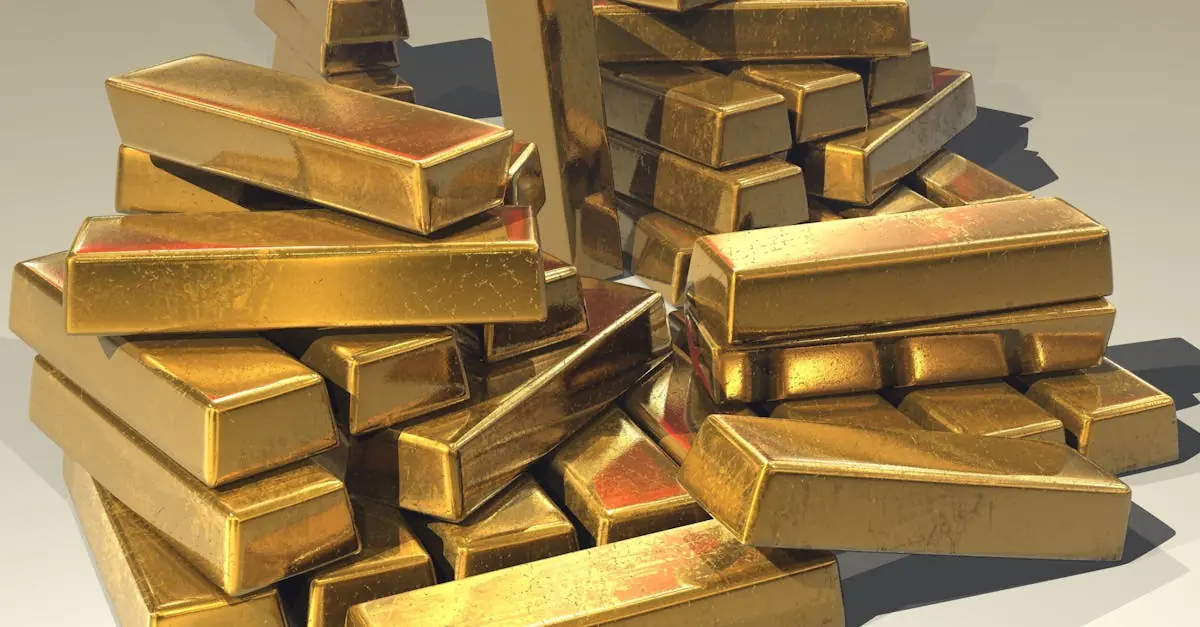In a world where financial markets can feel as unpredictable as a cat on a hot tin roof, precious metals investing stands out like a shiny beacon of stability. Gold, silver, platinum, and palladium aren’t just for pirates and kings; they’re for savvy investors looking to diversify their portfolios and hedge against inflation. Imagine your investments gleaming like a treasure chest, all while you sit back and sip your coffee, knowing you’ve made a smart move.
But why should anyone care about these shiny metals? Well, they’ve been valued for centuries and have a knack for keeping their worth when the going gets tough. Investing in precious metals isn’t just about bling; it’s about securing a piece of financial armor that can protect you from the wild swings of the market. So, let’s dive into the glittering world of precious metals and explore how they can add some serious sparkle to your investment strategy.
Table of Contents
ToggleOverview of Precious Metals Investing
Investing in precious metals serves as a strategic approach for wealth preservation and portfolio diversification. Gold, silver, platinum, and palladium hold historical significance and stability in times of economic uncertainty. Many investors view these metals as safe-haven assets that maintain value when traditional markets fluctuation occurs.
Gold often tops the list due to its universal acceptance and liquidity. As a result, it acts as a hedge against inflation and currency devaluation. Silver follows, presenting a dual role in both investment and industrial applications, which can lead to price volatility but offers significant upside potential.
Platinum and palladium, while less traditional, become attractive in specific market conditions. Both metals are vital for various industries, including automotive and electronics, enhancing their demand. Thus, investors looking to diversify can find opportunities in these lesser-known precious metals.
Physical ownership can manifest through bullion, coins, or ETFs, providing flexibility in investment strategies. Bullion appeals to those seeking tangible assets, while coins often have numismatic value that can enhance their worth. ETFs, on the other hand, offer convenience and lower transaction costs.
The performance of these metals hinges on multiple factors, including industrial demand, geopolitical tensions, and global economic trends. Tracking these dynamics helps investors make informed decisions. Thus, careful analysis and up-to-date information become crucial for anyone looking to participate in precious metals investing effectively.
Benefits of Investing in Precious Metals
Investing in precious metals provides numerous advantages for individuals seeking financial security. These benefits include a hedge against inflation and enhanced portfolio diversification.
Inflation Hedge
Precious metals such as gold and silver traditionally act as effective hedges against inflation. They tend to maintain or increase value when currency purchasing power declines. During periods of high inflation, investors often seek safe havens, leading to increased demand for these metals. Gold, in particular, consistently attracts attention as a reliable store of value. Historical trends reveal that gold prices often climb during inflationary pressures, offering protection to investors’ wealth. Investors may find comfort in knowing that precious metals can act as a safeguard, ensuring their assets endure economic fluctuations.
Portfolio Diversification
Adding precious metals to an investment portfolio significantly enhances diversification. These metals often respond differently than traditional assets like stocks and bonds during market volatility. When turbulent economic conditions arise, precious metals can exhibit stability, helping offset losses from other investments. Gold and silver tend to move independently of equity markets, providing a buffer against economic uncertainty. Allocation towards platinum and palladium also adds unique exposure, particularly in sectors such as automotive and technology. Investors may realize that incorporating precious metals fosters a balanced portfolio strategy capable of weathering diverse market scenarios.
Types of Precious Metals
Precious metals investing encompasses several key metals, each offering unique benefits and characteristics. Investors often consider gold, silver, platinum, and palladium as viable options within their portfolios.
Gold
Gold is the most recognized precious metal, revered for its intrinsic value and historical significance. It acts as a reliable store of wealth during economic uncertainty. Due to its widespread acceptance and ability to maintain value, investors frequently turn to gold when seeking portfolio stability. Liquidity remains a strong advantage, as buying and selling gold is straightforward anywhere in the world. Its significance as a hedge against inflation further solidifies gold’s position in investment strategies.
Silver
Silver serves dual purposes, functioning as both an investment asset and an industrial commodity. This metal is commonly used in electronics and solar technology, which can lead to price fluctuations based on industrial demand. Market traders often appreciate silver’s potential for significant price increases during demand spikes. Additionally, silver offers accessibility, allowing smaller investors to purchase it in various forms, such as coins and bars. Its historical role as a monetary standard enhances silver’s appeal in diversification efforts.
Platinum
Platinum’s rarity sets it apart from other precious metals, making it particularly valuable in investment portfolios. Industrial applications drive demand, especially in the automotive sector where it’s essential in catalytic converters. Investment in platinum can be strategic due to its price volatility during market fluctuations. Some investors view platinum as an alternative to gold, given its protective qualities against inflation and market downturns. As with gold and silver, understanding market dynamics significantly impacts platinum’s performance.
Palladium
Palladium is gaining attention, primarily for its role in the automotive industry alongside platinum. As emissions standards tighten globally, demand for palladium has surged, driving up its prices. Investors increasingly recognize palladium’s potential as a high-performing asset, especially in times of marketplace change. Its limited availability and industrial demand could contribute to strong price appreciation. With careful analysis, palladium presents opportunities for diversification within precious metals investing.
How to Invest in Precious Metals
Investing in precious metals involves several methods, each appealing to different investor needs. Understanding these options helps create a diversified investment portfolio.
Physical Metals
Investors often choose physical metals such as gold, silver, platinum, and palladium. Bullion and coins represent the most common forms of physical ownership. Bullion comes in bars or ingots and provides a high purity level. Coins, especially collectible ones, can carry additional value beyond metal content. Storing physical metals securely is crucial; investors often rely on bank safety deposit boxes or specialized storage facilities. Consideration of insurance to protect these assets from theft or damage becomes necessary. Precious metals serve as a tangible asset, offering peace of mind in uncertain financial climates.
ETFs and Mutual Funds
Exchange-traded funds (ETFs) and mutual funds offer another avenue for precious metals investing. ETFs typically track the price of metals, making them easily tradable on exchanges. Investors benefit from liquidity and reduced transaction costs compared to physical purchases. Mutual funds may provide broader exposure, including mining stocks and various precious metals. By investing in these funds, individuals gain diversification without needing to manage physical assets. Research into management fees and performance history becomes essential before selecting a fund. These investment vehicles simplify access to precious metals, appealing to those wanting to avoid the challenges of physical ownership.
Mining Stocks
Mining stocks represent a different approach to investing in precious metals. Investing in companies that explore and extract these metals allows for potential high returns if the company performs well. Market conditions impact mining stocks significantly; prices of the underlying metals and operational efficiency play crucial roles. An investor’s understanding of the mining sector, including geopolitical risks and production costs, becomes vital. Research into a company’s financial health and management helps make informed decisions about specific stocks. Mining stocks offer exposure to precious metals while adding an element of risk associated with individual company performance.
Risks and Considerations
Investing in precious metals carries inherent risks. Market fluctuations and storage issues can impact investment strategies significantly.
Market Volatility
Market volatility affects precious metals prices directly. Gold, silver, platinum, and palladium often experience fluctuations due to economic indicators. Investors should anticipate shifts triggered by changes in supply and demand, driven by geopolitical events or economic data releases. Silver, particularly, shows higher volatility due to its industrial applications. Prices can soar or drop depending on demand from sectors like electronics and renewable energy. Understanding these dynamics prevents unwelcome surprises. Many investors set specific thresholds for entry and exit to mitigate potential losses.
Storage and Security
Secure storage presents challenges for physical precious metals. Investors must choose options that prevent theft and damage. Safe deposit boxes represent one solution; however, they come with additional costs and accessibility issues. At-home safes provide convenience but require careful consideration of risks. Insurance to cover potential losses can add another layer of cost. Investors may also prefer ETFs and mutual funds, which eliminate physical ownership concerns. Deciding on the right storage approach hinges on individual preferences and risk tolerance. Prioritizing security ensures that precious metal investments remain safe and accessible.
Investing in precious metals offers a unique opportunity for those seeking stability and diversification in their portfolios. With their historical value and ability to withstand economic fluctuations, metals like gold, silver, platinum, and palladium can serve as effective hedges against inflation and market volatility.
Understanding the distinct characteristics and market dynamics of each metal is essential for making informed investment decisions. Whether opting for physical ownership or financial instruments like ETFs, the right approach can enhance an investor’s strategy.
As the financial landscape continues to evolve, incorporating precious metals can be a wise move for safeguarding wealth and achieving long-term financial goals.



